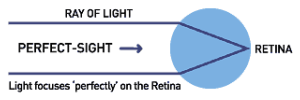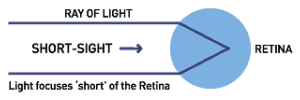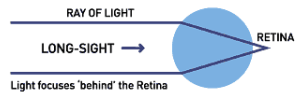
Optical Terms
This is also known as perfect sight where no prescription is required in order to see things clearly and comfortably. The fraction 20/20 is understood as follows: the bottom half represents the distance in meters at which a perfect sighted person is able to see clearly a target seen by another at 20 feet. So if you are perfect sighted you will see at 20 feet exactly what another perfect sighted person will see at 20 feet. However, if you have trouble seeing things in the distance, you might see at 20 feet what a perfect sighted person sees at 40 feet. So this means your vision is measured as 20/40.
Assuming you have perfect sight then when you are looking at something in the distance, light from the object will focus on your retinas very precisely. When seeing something close-up the focusing is blurred very momentarily, but this is unnoticeable because your eye has an automatic refocusing ability that makes the target clear. This refocusing ability is called 'Accommodation' and it works by making the natural lens of the eye fatter, or more convex in shape. As we get older we lose more and more of this ability, which is why things close-up start to blur after about 45 years of plodding on the planet.

Short-sightedness : Also known as Near-sight or Myopia, short-sighted individuals have trouble seeing things in the distance while anything close-up is clearer. This occurs because light from the objects being viewed focuses in front of the retina and not on it. It is believed that this mostly happens as a result of the eyeball being slightly too long. The scientific term for this is Axial Myopia.

Long-sightedness : Also known as Far-sight or Hyperopia, long-sighted individuals have difficulty with anything close-up while their general distance vision is not as bad. Light from objects viewed will theoretically focus behind the retina and not on it. However because the eye is able to naturally fatten the lens and cause light to bend more, this error in focus is overcome, which explains why distance vision is generally pretty good. When the same individual tries to look at something up close, much more effort is required, as light from a near object will fall much further back behind the retina. Vision at near is therefore worse.

Astigmatism : Often the eye is shaped like an egg or football. This is what we call astigmatism. It is quite a normal condition and most of us have to some degree. Like an egg, two main areas of curvature are found: one is flatter and the other is steeper. This causes the light to focus in two different positions such that the steeper or more curved area focuses further forward and the less curved or flatter further back. The effect on vision is to distort shapes so similarly shaped characters become confused. The letter G may be confused with a C and the number 2 may be mistaken for the letter Z.
Presbyopia : As our eyes grow older the ability to focus clearly on anything close-up starts to diminish. This occurs because we lose our ability to accommodate or make the lens of the eye fatter in shape. One popular way of explaining how this happens likens the natural lens of the eye to a pillow with feathers inside. The lens contains many fibres (feathers) which grow throughout life in the same way that hair and skin continues to grow. This is not surprising considering that these tissues all come from the same founding cells. When the lens is younger and has fewer fibres it is more flexible and can change its shape more easily just as a pillow with fewer feathers can. When the lens is older and has many more fibres this flexibility is obviously lost which causes the near vision to blur.
Lenses have the ability to bend light or change its direction. A minus-powered lens causes light to diverge once it has passed through, while a plus-powered lens does the opposite by converging the light towards a point. A minus lens is generally thicker at the outside edges than at the center and a plus lens is thicker at its center than at the edge. This applies to both spectacle and contact lenses.

Minus Lenses and Short-sight : As the short-sighted eye focuses light in front or short of the retina it makes sense to use a minus lens to take the focus back to the retina. It changes the direction of light before it enters the eye by making it more divergent. This, coupled with the normal focusing of the short-sighted eye, serves to place the focal point back on the retina assuming the correct strength of prescription has been used.

Plus Lenses and Long-sight : The visual experience of presbyopia is the same as that for long-sight such that near objects are blurry. The difference is that long-sighted individuals have a prescription for their distance as well as near vision and that prescription is always plus-powered. Presbyopes have a more plus-powered prescription up close only, while their distance vision could be perfect, short-sighted or even astigmatic. So whatever the individuals distance prescription may be, the near prescription is invariably always different.

Plus Lenses and Presbyopia : The visual experience of presbyopia is the same as that for long-sight such that near objects are blurry. The difference is that long-sighted individuals have a prescription for their distance as well as near vision and that prescription is always plus-powered. Presbyopes have a more plus-powered prescription up close only, while their distance vision could be perfect, short-sighted or even astigmatic. So whatever the individuals distance prescription may be, the near prescription is invariably always different.
Toroidal Lenses and Astigmatism : The astigmatic eye possesses two main areas of curvature causing light to focus shorter along one curve and further back along the other. Since minus lenses push the focus of light further back and plus lenses bring focal points forwards, a combination of the characteristics of these lenses in a single lens would solve the problem of astigmatism. This lens form is termed toroidal and in contact lenses the term toric is often used.
Bifocals - The gradual decrease in ability of the eye to focus is a natural part of the aging process. Bifocals contain two prescriptions for correcting vision at different distances. Bifocals aid both near and far vision, with a visible line dividing the two areas of power prescription.
Trifocals - Trifocals are prescribed to aid near, far and middle distance seeing. The trifocal lens design has three distinct areas of power to be used, with visible lines dividing the three distinct areas of power prescription.
Blended multi-focals - These lenses have two focal corrections without the noticeable lines. The area that fuses the two powers together is unusable area.
Progressive flat-tops - These lenses change power gradually as the eye moves down through the near segment allowing a range of ten inches to ten feet. One visible line divides the distant power prescription to the intermediate and near prescription.
Progressive no lines - Advanced technology allows these lenses to gradually change in power from the distance segment to the near vision segment Your specific prescription is ground from a series of custom lens designs and powers.
Single vision - One focal distance is required for your eyes to make adjustments at differing focal distances.
Your prescription defines the optical requirements of your eyes and can be broken down into separate parts.
- Sphere - This refers to the amount of long sightedness (hypermetropia) or short sightedness (myopia).
- Cyl or Cylinder - The amount of astigmatism or distortion in your vision.
- Axis - This is the direction of the cylinder (astigmatism).
If you have astigmatism, then the cylinder is specified and this is always accompanied by the axis as they both go together. However your prescription may be a spherical only, cylinder and axis only or a combination of sphere, cylinder and axis.
Add or Addition - This is the additional strength required for reading, and is an age related disorder and normally only required for people over 40 years because presbyopia has set in.
Whilst all prescriptions have common features they can be written in slightly different ways, such as:
RE +2.25/+1.50x20 LE +1.75 Add +1.25
OR
| Sphere | Cyl | Axis | Add | |
| Right Eye | +2.25 | +1.50 | 20 | +1.25 |
| Left Eye | +1.75 | +1.25 |
Some common prescription abbreviations:
SPH or sph = SPHERE power; the overall power
CYL or cyl = CYLINDER power; the amount of astigmatism
X = axis; X 90 means AXIS 090
ADD = how much power gets added to the distance prescription for reading
Pl or - is equal to PLANO; it’s used for the number zero
Pupillary Distance : Pupilliary distance is the distance between the pupils of the eyes when looking far away in the distance. Your PD is measured in millimetres. Near PD is the distance between the pupils of your eyes when you are focusing at a near object. Usually there is a difference of about 4 – 5 mm between distance PD and near PD.
When prescription lenses are cut for the frame you have selected, the edging computers are programmed with your pupil distance so that the exact centres of the lenses are directly in front of your pupils
We dispense quality lenses for best comfort and vision.